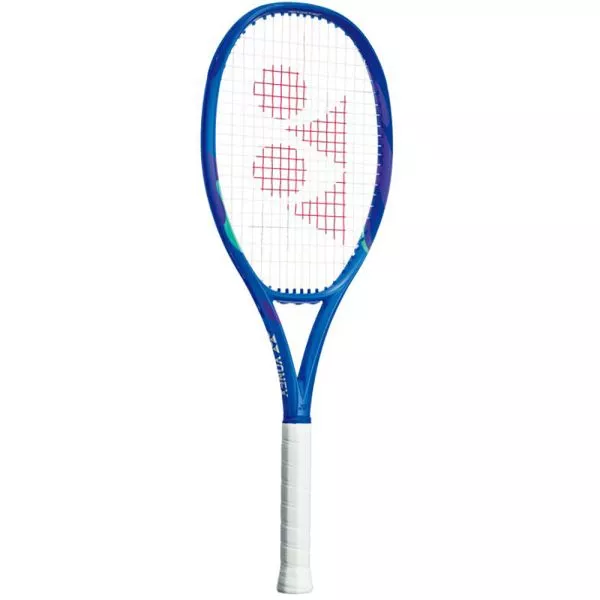But what is topspin? How do you hit this topspin, and when should you use it when playing tennis?
We’ve got the answers for you. Let’s take a closer look at the types of spin used when hitting a tennis ball.
TOPSPIN VS. BACKSPIN
There are two main types of spin you can use when playing tennis: topspin and backspin. Topspin is the most used form of spin, and it consists of players using a “low-to-high” swing path to hit over the top of the ball.
The ball is then rotating in a forward manner, and this rotation really grabs the ball and allows it to bounce higher off the ground.
Backspin, on the other hand, is another type of spin used to hit shots in tennis. Rather than hitting over the top of the ball, backspin shots are hit using a more “high-to-low” swing path to cut under the ball.
This shot is also known as the “slice,” and the backward rotation on the ball stays low to the ground after the bounce.
WHY SPIN?
So what’s the big commotion about spin? What effect does topspin have on the ball and what are its benefits? And why are so many players gravitating toward this game style? Great questions you ask.
To begin, it was not as common for players to hit with that much spin several years ago simply because the rackets and strings were not made to accommodate that game style. Points were shorter, and the game was more about precision and feel as opposed to power.
Today, however, both spin and power are huge players in the game. With the latest innovations in performance rackets and strings, it’s very easy to understand why players are looking to incorporate both heavy spin and explosive power into their shots. For starters, spin is an extremely reliable shot that allows more balls to stay in. (Think more spin = more in).
Both baseline groundstrokes and serves, particularly the kick serve, are shots that can really benefit from increasing the RPMs. Players can back up all the power they put into the ball by finishing their swing or flicking their wrist with topspin, which adds more margin and brings the ball back down into the court.
Not only do more balls stay in the court when hitting with topspin, this shot is also much more effective than a flat, linear ball. Players are comfortable hitting shots in their strike zone around hip height. Spin, however, produces biting shots that bounce extremely high after hitting the ground.
This difficult shot forces players to take extra small adjustment steps to hit the ball in their strike zone. And after a long hour of playing, your opponent might not be able to keep up with that intensity.
-

 40% Off + 5%*Select options This product has multiple variants. The options may be chosen on the product page
40% Off + 5%*Select options This product has multiple variants. The options may be chosen on the product page₹29,999.00Original price was: ₹29,999.00.₹17,999.00Current price is: ₹17,999.00. -

 40% Off + 5%*Select options This product has multiple variants. The options may be chosen on the product page
40% Off + 5%*Select options This product has multiple variants. The options may be chosen on the product page₹25,800.00Original price was: ₹25,800.00.₹15,535.00Current price is: ₹15,535.00. -

 42% Off + 5%*Select options This product has multiple variants. The options may be chosen on the product page
42% Off + 5%*Select options This product has multiple variants. The options may be chosen on the product page₹20,925.00Original price was: ₹20,925.00.₹12,120.00Current price is: ₹12,120.00. -

 42% Off + 5%*Select options This product has multiple variants. The options may be chosen on the product page
42% Off + 5%*Select options This product has multiple variants. The options may be chosen on the product page₹21,890.00Original price was: ₹21,890.00.₹12,690.00Current price is: ₹12,690.00. -
 35% Off + 5%*Select options This product has multiple variants. The options may be chosen on the product page
35% Off + 5%*Select options This product has multiple variants. The options may be chosen on the product page₹13,499.00Original price was: ₹13,499.00.₹8,770.00Current price is: ₹8,770.00. -

 38% Off + 5%*Select options This product has multiple variants. The options may be chosen on the product page
38% Off + 5%*Select options This product has multiple variants. The options may be chosen on the product page₹30,999.00Original price was: ₹30,999.00.₹19,220.00Current price is: ₹19,220.00. -

 37% Off + 5%*Select options This product has multiple variants. The options may be chosen on the product page
37% Off + 5%*Select options This product has multiple variants. The options may be chosen on the product page₹33,999.00Original price was: ₹33,999.00.₹21,449.00Current price is: ₹21,449.00. -
₹6,690.00Original price was: ₹6,690.00.₹4,350.00Current price is: ₹4,350.00. -
₹6,690.00Original price was: ₹6,690.00.₹4,350.00Current price is: ₹4,350.00. -
₹6,690.00Original price was: ₹6,690.00.₹4,350.00Current price is: ₹4,350.00. -

 42% Off + 5%*Select options This product has multiple variants. The options may be chosen on the product page
42% Off + 5%*Select options This product has multiple variants. The options may be chosen on the product page₹21,890.00Original price was: ₹21,890.00.₹12,690.00Current price is: ₹12,690.00. -
₹4,499.00Original price was: ₹4,499.00.₹2,975.00Current price is: ₹2,975.00.
THE SPIN RACKET YOU NEED
The three features listed above will complement your game style and allow your topspin shots to be so much more effective. An open string pattern will do a better job of gripping the ball and allowing it to move across the string bed, and a flexible frame can move with the ball and provide extra rotations.
Common open string patterns include 16×19 and 16×20, where the first number indicates the horizontal strings (mains) and the second indicates the vertical strings (crosses). These are considered open because there is more space in between the mains and crosses, which allows the strings to grip the ball and increase the revolutions after leaving the string bed.
A dense string pattern, on the other hand, includes the 18×20 because there is less space in between the mains and crosses within the same area of the frame.
When it comes to selecting a spin-friendly racket, we suggest that you try out the latest Shift V1.
This is the first performance racket of its kind to be finalized based on feedback from players worldwide. We heard your voice, and we knew that you wanted a racket that could provide spin, controllable power, and comfort.
Michael Schaeffer, Wilson’s Global Product Director for Racquet Sports, chimed in on how the latest Shift racket is capable of all these qualities.
“Shift is a continuation of our learnings on the innovation side of how a tennis racket bends. With Shift, we were able to figure out ways to control all the different bending moments of a tennis racket: how much the racket bends both horizontally and vertically, as well as how much it twists.
When we figured out how to make a racket bend in all these different directions, we then spent the next few years creating rackets with all these unique characteristics and bending profiles that we could test and get consumer feedback on. This resulted in a racket that was very flexible laterally and very firm horizontally.
This combination of this bending profile together allows you to hit the ball with a lot of power through the court, but also with a lot of spin.”
-
₹1,229.00Original price was: ₹1,229.00.₹999.00Current price is: ₹999.00. -
₹1,089.00Original price was: ₹1,089.00.₹820.00Current price is: ₹820.00. -
₹849.00Original price was: ₹849.00.₹650.00Current price is: ₹650.00. -
₹379.00Original price was: ₹379.00.₹299.00Current price is: ₹299.00. -
₹379.00Original price was: ₹379.00.₹299.00Current price is: ₹299.00. -
₹379.00Original price was: ₹379.00.₹299.00Current price is: ₹299.00.



















